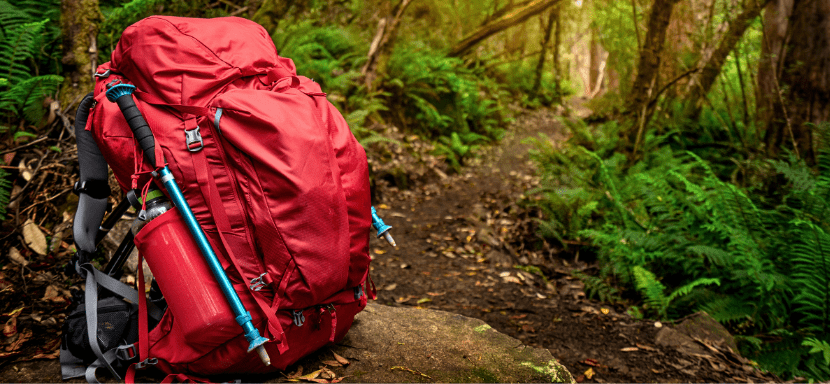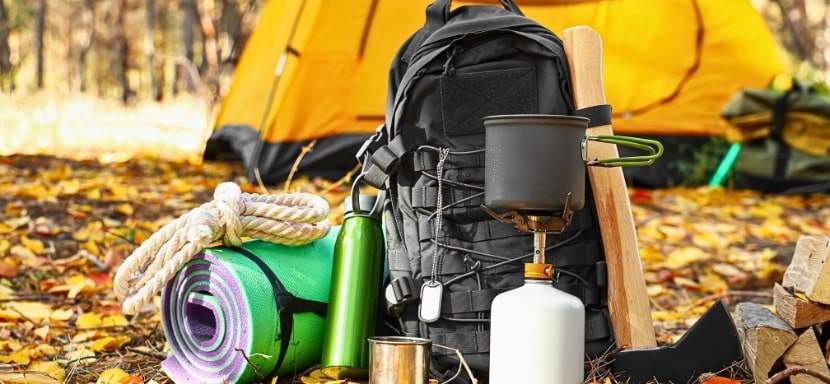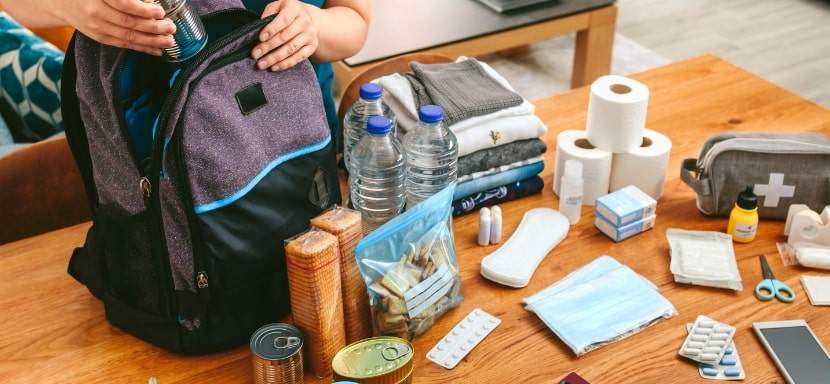The Ultimate Guide to Building a Bug-Out Bag

How to Build a Bug-Out Bag
In an unpredictable world, being prepared for emergencies is paramount.
A well-equipped bug-out bag (BOB) is your lifeline during unexpected situations.
This comprehensive guide will walk you through creating a bug-out bag that ensures you’re ready for anything, from natural disasters to sudden evacuations.
Did You Know?
Experts suggest that every go-bag contains feminine products. Along with their intended use, they work well as bandages.
What Is a Bug-Out Bag?
A bug-out bag is a portable kit that contains all the essential items you need to survive for the first 72 hours after a disaster.
It’s designed to help you evacuate quickly and safely, providing support until you reach a safer location or help arrives.
Understanding the Purpose of a Bug-Out Bag
A bug-out bag is more than just a collection of survival items. It’s your lifeline in situations where staying put becomes unsafe. It’s designed to help you evacuate quickly and survive for at least 72 hours. This section explores the philosophy behind a bug-out bag, emphasizing the importance of preparedness and adaptability.
- Preparedness Philosophy: A bug-out bag is a proactive measure, embodying the readiness to face emergencies head-on. It’s about anticipating potential crises and equipping oneself to navigate them confidently.
- Essential Survival Kit: At its most basic, a BOB is designed to support survival for 72 hours after evacuating from a disaster. It includes necessities for shelter, water, food, and safety.
- Symbol of Self-Sufficiency: More than just survival items, a bug-out bag symbolizes an individual’s commitment to protect themselves and their loved ones, emphasizing the importance of self-reliance.
- Customizable and Adaptable: There’s no universal bug-out bag; each one should be tailored to meet the specific needs and circumstances of its owner, reflecting personal health needs, local risks, and survival skills.
- Foundation for Comprehensive Preparedness: Building a bug-out bag is a starting point for broader emergency preparedness efforts, encouraging a holistic approach to planning for both short-term crises and long-term survival scenarios.
Why You Should Have a Bug-Out Kit
Imagine you’re at home when suddenly, an earthquake hits. Power’s out, chaos is everywhere, and you’ve got to get your family to safety, fast.
Here’s where your bug-out bag becomes your best friend. Packed with essentials like water, food, a first-aid kit, and a flashlight, this bag is your lifeline for the next 72 hours. You remember the map and compass you stashed in there, guiding you away from the crowded chaos toward safety.
This scenario is precisely why having a bug-out bag ready isn’t just brilliant; it’s crucial.
It’s about being prepared for the unexpected, ensuring you and your loved ones have what you need when every second counts.
Building Your Bug-Out Bag: A Step-by-Step Guide
Start by selecting a sturdy and comfortable backpack, then gather necessary survival items, emphasizing quality and efficient use of space.
We suggest organizing the bag for easy access and weight balance, personalizing it with items specific to individual health and dietary needs, and maintaining it by regularly updating and replacing its contents.
This comprehensive approach ensures the bug-out bag is always ready for any emergency.
- Selecting Your Bag: Opt for a durable, comfortable-to-carry, and appropriately sized backpack.
- Gathering Essentials: Use the list below to collect all necessary items, focusing on quality and compactness.
- Organizing Your Bag: Pack items based on accessibility and frequency of use. Keep heavy items close to your back.
- Personalizing Your Kit: Consider your unique needs, including medications, glasses, and dietary requirements.
- Maintaining Your Bag: Regularly check and update your bag, replacing expired items and adjusting for seasonal changes.

Essentials for Your Bug-Out Bag
When crafting your bug-out bag, each item you choose to include should serve a purpose, aiding in survival, providing comfort, or ensuring security in uncertain times.
The essentials are divided into categories, each vital for different survival aspects. Let’s investigate these categories, unpacking why each is critical and what to consider when selecting your gear.
1. Water and Hydration Solutions
Water isn’t just a necessity; it’s the cornerstone of survival. The human body can survive weeks without food but only days without water.
Here’s what to include:
- Water Filters and Purifiers: Compact, portable water filters and purifiers can remove pathogens from natural water sources.
- Collapsible Water Containers: Space-efficient and lightweight, these are crucial for storing and carrying water.
- Hydration Packs: Integrated into your bag, they allow for easy access to water without having to stop and dig through your pack.
- Water Purification Tablets: As a backup to filters, these tablets can purify water when other methods are not available.
2. Food and Nutrition
The goal is high energy and nutrients while retaining low weight and volume.
Consider these options:
- Energy Bars and Protein Bars: Packed with calories and nutrients, these are perfect for on-the-go sustenance.
- Dried Fruits and Nuts: Offer vitamins and energy in a compact form.
- Ready-to-Eat Meals: Military-grade MREs or civilian freeze-dried meals provide variety and convenience.
- Cooking Tools: A small, portable stove and cookware for preparing hot meals from dried goods.
3. Shelter and Warmth
Protection from the elements can mean the difference between life and death:
- Compact Tents or Bivy Sacks: Offer shelter from wind, rain, and snow.
- Sleeping Bags: Look for lightweight, compact options rated for various temperatures.
- Thermal Blankets: Reflective emergency blankets can prevent hypothermia in a pinch.
- Insulated Ground Pads: Provide insulation from the cold ground.
4. Clothing and Personal Items
Your clothing should be versatile, layerable, and suitable for all possible conditions:
- Moisture-Wicking Base Layers: Keep you dry and comfortable.
- Insulating Layers: Fleece or wool sweaters/jackets for warmth.
- Waterproof Outerwear: Protects against rain and wind.
- Durable Footwear: Waterproof, comfortable boots are a must.
- Personal Hygiene Items: Toothbrush, toothpaste, soap, and other essentials to maintain health and morale.
5. First Aid and Health Supplies
A comprehensive first-aid kit should include the following:
- Basic First Aid Supplies: Bandages, gauze, adhesive tape, antiseptic wipes, and blister treatment.
- Medications: Pain relievers, allergy medications, and any prescription medications.
- Tools: Tweezers, scissors, and a thermometer.
- Protection: Sunscreen, insect repellent, and lip balm.
6. Survival Tools and Equipment
Tools can make survival tasks easier and faster:
- Multi-tools: Versatile and compact, they can perform many tasks.
- Knives: A sturdy, sharp knife is invaluable for preparation and protection.
- Fire Starters: Waterproof matches, lighters, and ferro rods for making fire under any conditions.
- Duct Tape: Fixes everything from torn gear to makeshift shelter repairs.
7. Communication Devices and Navigation Tools
Staying informed and knowing where you are can help you make intelligent decisions:
- Hand-Crank/Solar-Powered Radio: Keeps you updated on the situation without relying on batteries.
- Compass and Maps: Essential for navigation if GPS is unavailable.
- Solar Chargers: Keep your devices powered in the absence of electricity.
- Whistle: For signaling help.
8. Personal Documents and Cash
In emergencies, having access to your identity and resources is crucial:
- Copies of Personal Documents: ID, passport, medical records, and emergency contact information.
- Cash: ATMs and credit card machines may not be operational. Have some money and make sure they are small bills.
9. Survival Skills and Knowledge Resources
Knowledge is as crucial as any physical tool:
- Survival Manuals: Can offer guidance on various survival techniques and first aid.
- Local Maps and Guides: Knowing the area can lead you to resources and help you avoid danger.
- Practice: Regularly review and practice survival skills to ensure readiness.

Choosing the Right Bag
Choosing the right bug-out bag (BOB) is critical for effective emergency preparedness. Here’s a concise guide to help you make the best choice:
Factors to Consider
- Size and Capacity: Aim for 40-70 liters, balancing supply needs with mobility.
- Comfort and Fit: Look for adjustable straps, padding, and weight distribution features like sternum straps and hip belts.
- Durability and Water Resistance: Choose high-denier nylon for toughness, water-resistant materials, or a rain cover bag.
- Compartments and Accessibility: Opt for multiple compartments for organization, including specific pockets for ease of access.
- Discreet Appearance: A civilian-looking bag is preferable for blending in and avoiding unwanted attention.
Top Recommended Bug-Out Bags
- 5.11 Tactical RUSH72 Backpack: Durable, 55-liter capacity, with balanced weight design.
- Osprey Atmos AG 65 Backpack: Features an Anti-Gravity suspension system for comfort, ideal for long distances.
- Maxpedition Falcon-II Backpack: Compact and water-resistant, great for modular customization.
- Kelty Redwing 50 Backpack: Versatile, travel-friendly design with efficient organization.
- GORUCK GR1: Extremely durable, simple design with a laptop/hydration compartment.
Selecting the right bag involves considering your physical capacity, the duration you need to be self-sufficient, and the conditions you expect to face. The right choice will support your survival strategy without compromising comfort or mobility.
Customizing Your Bug-Out Bag for Specific Scenarios
Customizing your bug-out bag (BOB) to fit specific scenarios ensures you’re prepared for any environment or situation. Different settings require unique strategies and supplies, from navigating the concrete jungle of urban environments to surviving in the wilderness or ensuring your family’s safety. Here’s how to tailor your BOB for urban survival, wilderness survival, and family preparedness.
Urban Survival
Navigating urban environments during a crisis involves challenges like dense populations, limited resources, and potential security threats. Customize your BOB with these essentials:
- Multi-Tool and Lock Picking Set: For navigating through or around urban obstacles.
- Compact Shelter Options: Reflective emergency bivvy or a lightweight tent that can be set up in tight spaces.
- Water Purification Solutions: More emphasis on purification tablets and portable filters, as you’ll likely encounter more contaminated water sources.
- Discreet Self-Defense Tools: Non-lethal options like pepper spray or a taser, keeping in mind local laws.
- Cash and Barter Items: Small denominations of currency and items valuable for trade.
- Maps and a Compass: This is for navigation when digital tools may fail.
- Solar Charger: Keep your communication devices powered in prolonged blackouts.
Wilderness Survival
Surviving in the wilderness demands gear that helps you navigate, hunt, or forage and protect yourself against the elements:
- High-Quality Knife: Essential for everything from building shelter to preparing food.
- Topographic Maps and Compass: For navigation across varied terrain.
- Water Filtration System: Streams and lakes can be water sources with a reliable filter.
- Lightweight, Durable Shelter: A tarp or small tent that’s easy to carry but reliable against the elements.
- Fire Starting Tools: Waterproof matches, ferro rod, and tinder.
- Hunting and Fishing Supplies: Compact fishing kit, snares, or a slingshot for procuring food.
- Signal Mirror and Whistle: For rescue and signaling over long distances.
Family Preparedness
When preparing a BOB with family in mind, consider each member’s needs, from infants to older people, to ensure everyone’s well-being:
- Individual Essentials Bags: Smaller bags for each family member with personal items, medications, and comfort items.
- Child-Friendly Food and Water: Include snacks and hydration options suitable for children.
- Entertainment and Comfort Items: Books, games, or toys to keep children calm and occupied.
- Extra Medications and First Aid Supplies: Cater to any specific health needs within the family.
- Family Tent: Accommodate the entire family for shelter.
- Communication Plan and Contacts: Ensure everyone knows what to do and who to contact in case of separation.
- Photo IDs and Documentation: This is for all family members if you need to verify relationships or navigate through checkpoints.
Customizing your BOB for specific scenarios requires thoughtful consideration of each environment or situation’s unique challenges and needs. By tailoring your kit, you enhance your resilience and ability to thrive, regardless of what the world may throw your way.
Maintaining and Updating Your Bug-Out Bag
Maintaining and updating your bug-out bag (BOB) is crucial to ensure that, in an emergency, your gear is functional, your supplies are fresh, and your information is up to date.
A well-maintained BOB provides peace of mind and can significantly increase your chances of survival during a crisis.
Here are a few tips for keeping your bug-out bag in top condition:
Regular Inspection
- Schedule Checks: Perform a detailed inspection of your BOB at least twice a year. Many people find it helpful to do this with daylight saving time changes to ensure consistency.
- Check Expiry Dates: Go through all perishable items, such as food, water purification tablets, and batteries, and replace anything near its expiration date.
- Gear Functionality: Test all equipment, including flashlights, radios, and multi-tools, to ensure everything works. Look for wear and tear on items like backpacks and clothing, and replace or repair as necessary.
Seasonal Adjustments
- Adapt to the Climate: Adjust your BOB contents according to the season. For example, include extra insulation during winter months and lighter clothing for the summer.
- Weather-Specific Gear: Consider adding sun hats and sunscreen for summer or thermal blankets and hand warmers for winter.
Update Based on Changes in Circumstances
- Personal or Family Needs: Update your kit to reflect any changes in your or your family’s medical needs, dietary restrictions, or size (e.g., clothing and shoes for growing children).
- Relocation: If you move to a different geographic area, reassess your BOB based on local risks—such as flooding, earthquakes, or snowstorms—and adjust your gear and supplies accordingly.
Knowledge and Skills Upkeep
- Stay Informed: Keep current with new survival techniques and technologies that could make your BOB more effective. Include updated guides or reference materials that cover these new skills.
- Practice and Training: Regularly practice using the items in your BOB, especially tools like fire starters or water filters. To enhance your preparedness, consider enrolling in first aid, wilderness survival, or self-defense courses.
Documentation Updates
- Emergency Contacts and Personal Documents: Ensure that all personal documents, emergency contact information, and maps are current. Consider the implications of recent changes in phone numbers, addresses, or personal circumstances.
Inventory Management
- Keep an Inventory List: Maintain a detailed list of everything in your BOB, including expiration dates and maintenance schedules for gear. This list can be invaluable in ensuring that nothing is overlooked during inspections and updates.
Engage Family Members
- Involvement in Maintenance: If your BOB is designed to support multiple people, involve your family or household members in the maintenance process. This ensures everyone knows what is in the BOB and how to use the contents.

Common Mistakes to Avoid
Common pitfalls can undermine even the most well-intentioned efforts when assembling and maintaining a bug-out bag (BOB). Awareness and proactive avoidance of these mistakes can significantly enhance preparedness.
Here are some of the most frequent errors to steer clear of:
Overpacking
- The Pitfall: It’s tempting to include everything you might need, but an overly heavy bag can slow you down and increase fatigue.
- Avoidance Strategy: Stick to essentials that cover basic survival needs. Prioritize multipurpose items to minimize weight and bulk.
Neglecting Personal Needs
- The Pitfall: Generalized BOB lists are helpful but might not cover specific personal or family needs, such as prescription medications or children’s items.
- Avoidance Strategy: Customize your BOB based on personal health requirements, dietary restrictions, and other necessities.
Forgetting Water Purification
- The Pitfall: Underestimating the importance of reliable water sources and purification methods can lead to dehydration or illness from contaminated water.
- Avoidance Strategy: Include multiple water purification solutions, such as filters and purification tablets, and know the locations of natural water sources along your planned routes.
Ignoring Bag Quality
- The Pitfall: Opting for a cheap or low-quality backpack can result in tears, broken straps, or other failures when needed.
- Avoidance Strategy: Invest in a durable, high-quality bag for rugged use. Ensure it has a comfortable fit and adequate space for your gear.
Overlooking Seasonal Changes
- The Pitfall: The same gear may not be suitable year-round, leading to discomfort or danger in extreme temperatures.
- Avoidance Strategy: Seasonally adjust your BOB’s contents to ensure you have appropriate clothing, shelter, and sleeping gear for the current weather conditions.
Not Practicing with Your Gear
- The Pitfall: Unfamiliarity with the equipment in your BOB can waste valuable time and resources during an emergency.
- Avoidance Strategy: Regularly practice using every item in your BOB, from setting up shelter to purifying water, to ensure efficiency and proficiency under stress.
Lack of Documentation
- The Pitfall: Failing to include essential documents can complicate identification, travel, and resource access during evacuations.
- Avoidance Strategy: Keep updated copies of personal identification, medical records, and emergency contact information in your BOB.
Forgetting to Rotate Supplies
- The Pitfall: Perishables and other time-sensitive items can expire, leaving you with ineffective or dangerous supplies.
- Avoidance Strategy: Regularly check and rotate out food, water, batteries, and medication to ensure everything in your BOB is fresh and functional.
Training and Preparedness Exercises
Training and preparedness exercises are crucial for maximizing the effectiveness of your bug-out bag (BOB) and ensuring you’re ready for any emergency. Here’s a concise guide to integrating training into your preparedness plan:
Regular Drills
- Evacuation Drills: Practice quick home evacuation with your BOB to improve speed and adaptability under various scenarios.
- Gear Familiarization: Regularly use every item in your BOB, such as setting up shelters and purifying water, to ensure proficiency.
Skill Enhancement
- First Aid: Learn basic first aid and CPR through certified courses.
- Survival Techniques: Acquire skills in navigation, food foraging, and water identification through workshops or online resources.
- Self-Defense: Boost your safety by learning self-defense techniques.
Scenario Planning
- Mock Emergencies: Simulate potential disasters relevant to your area, practicing your response using your BOB and survival knowledge.
- Situational Awareness: Develop the ability to assess and adapt to changing conditions through mental exercises and staying informed on disaster scenarios.
Family Involvement
- Include Family in Drills: If your BOB supports multiple people, involve them in practice drills and make sure everyone understands emergency procedures.
- Community Engagement: Join or organize local emergency preparedness activities to share knowledge and strengthen communal ties.
Continuous Learning
- Review and Update: After training, evaluate what improvements can be made to your BOB or strategy.
- Stay Updated: Learn and integrate new survival skills into your training regimen.
Advanced Tips for the Seasoned Prepper
For seasoned preppers who have mastered the basics of emergency preparedness and bug-out bag (BOB) assembly, advancing your readiness involves refining strategies, exploring new technologies, and deepening your self-reliance skills.
Here are some advanced tips to consider:
Strategic Redundancy
- Layered Preparedness: Implement redundancy in critical areas such as water purification, fire starting, and navigation. However, balance this with the need to keep your BOB lightweight and manageable.
Advanced Skills Development
- Wilderness Survival Courses: Engage in advanced courses that cover survival in various environments, focusing on skills like hunting with primitive tools, edible and medicinal plant identification, and advanced navigation techniques.
- Urban Survival Skills: Learn about urban evasion, lock picking, and blending into chaotic environments without drawing attention.
Technological Enhancements
- Solar Power Innovations: Invest in lightweight, efficient solar chargers and power banks to ensure your electronic devices remain functional without access to power grids.
- GPS and Satellite Messengers: While basic navigation skills are essential, advanced technology can provide additional security and communication capabilities in remote areas.
Health and Fitness
- Physical Preparedness: A high level of physical fitness can significantly increase your chances of survival. Tailor your fitness regimen to include endurance, strength, and flexibility training relevant to survival scenarios.
- Mental Resilience: Practice stress management techniques and mental resilience exercises. Preparedness is as much about mental strength as it is about physical capabilities.
Community and Network Building
- Prepper Networks: Build relationships with fellow preppers in your area or online. Sharing knowledge, skills, and resources can offer mutual support and broaden your perspective on preparedness.
- Teaching and Mentoring: Share your knowledge by teaching others. This can reinforce your skills and offer fresh insights into your preparedness strategies.
Continuous Learning and Adaptation
- Stay Informed: Keep up with the latest survival tactics, gear innovations, and global emergency trends. The world of preparedness is constantly evolving, and staying informed is critical to staying ahead.
- Scenario Planning: Regularly update your emergency plans and BOB contents based on new learnings, changing personal circumstances, and evolving global risks.
For the seasoned prepper, continually learning, adapting, and overcoming complacency is essential for advancing their preparedness level.
Integrating these advanced tips into their strategy can enhance their resilience, broaden their survival skill set, and ensure they’re prepared for even the most challenging scenarios.
Community Resources and Further Learning
Leveraging community resources and engaging in continuous learning are vital for enhancing preparedness skills.
Here’s how to integrate these into your preparedness plan effectively:
Community Resources
- Attend Workshops: Offered by local emergency services, these provide essential skills in first aid and disaster response.
- Join Groups: Connect with local or online prepper and survivalist communities for shared knowledge and group training.
- Utilize Libraries: Access a wealth of books and resources on survival skills and local geography.
- Community College Courses: Enroll in classes related to wilderness survival and first aid for structured learning.
Further Learning
- Online Learning: Platforms like Coursera and Udemy offer courses on various survival topics, from bushcraft to emergency medicine.
- Attend Expos: Survival and preparedness expos are fabulous for workshops, gear demos, and networking with experts.
- Read Widely: Invest in survival guides, military manuals, and books on edible plants and herbal medicine.
- Experience Field Training: Participate in survival camps or courses to practice skills in real-world scenarios.
Mentorship and Sharing
- Seek a Mentor: Find an experienced prepper for guidance and hands-on learning.
- Teach and Share: Strengthen your knowledge by teaching others through informal workshops or online content.
Stay Engaged
- Keep Learning: The field of preparedness evolves, so stay informed on new strategies and technologies.
Mastering Preparedness: The Ultimate Guide to Your Bug-Out Bag
Building and maintaining an optimized bug-out bag (BOB) is a fundamental pillar in the emergency preparedness journey. This guide has walked you through every step, from understanding the purpose of a BOB to selecting the right gear, customizing your kit for various scenarios, and engaging in continuous learning and community resources. Regular maintenance, training, and avoiding common pitfalls have been emphasized to ensure that your bag remains a reliable survival toolkit.
Remember, the essence of preparedness lies not just in the items you pack but in the knowledge you hold, the skills you develop, and the community you build. Whether you’re a novice starting on this path or a seasoned prepper looking to refine your strategy, the journey toward preparedness is ongoing. Embrace the mindset of continuous improvement, adaptability, and resilience.
As we conclude this guide, remember that the ultimate goal is to ensure your safety and the well-being of those you care about in any emergency. Your bug-out bag is critical to this goal, but your preparedness, awareness, and willingness to adapt genuinely make the difference. Stay informed, stay prepared, and stay safe.
In crafting your ultimate bug-out bag, you’re not just preparing for emergencies but embracing a lifestyle of readiness and responsibility. Let this guide be your stepping stone to mastering preparedness, ensuring that when the unexpected occurs, you’re ready to survive and thrive.

More Survival Tips and Advice

How to Protect Yourself From Insects in the Wild
There’s nothing like being out in the wild—birdsong echoing through the trees, the fresh scent of earth, and a deep sense of peace that makes you think, “Ah, this is what life is about.” But then comes the buzzing. Mosquitoes, ticks, and flies swoop in like uninvited...

How to Identify Poisonous Plants
Exploring the great outdoors can be incredibly refreshing, offering a chance to reconnect with nature and unwind from daily stresses. However, it also comes with its fair share of risks. Chief among them? Poisonous plants. These hidden hazards can turn a peaceful...

How to Use the Sun to Tell Time
Using the sun to tell time sounds like a Robinson Crusoe novel. Imagine being stranded on a desert island with no phone, clock, or sundial. You'd still have one incredibly reliable resource: the sun. It’s been doing its thing for billions of years, and by the looks of...

How to Purify Water Using Boiling
When you're miles away from civilization, lost in the wilderness, or don't trust what's coming out of your tap, the idea of pure, clean drinking water starts to sound like a mythical oasis. Maybe it's all those survival shows you've binged, but suddenly, you're eyeing...

How to Build a Faraday Cage
Have you ever had one of those moments when your phone seems to be on its own personal field trip through Wi-Fi signals, Bluetooth, and all kinds of electromagnetic noise? Well, I have. The endless hum of invisible waves flying through the air makes you wonder—how can...
More Survival Scenarios

How to Survive a Drug Test
The Cup, The Room, The Truth I never imagined I’d be so emotionally invested in a paper cup. But there I was, standing under the fluorescent hum of a strip-mall clinic, trying to recall the last time I ate a poppy seed bagel. That’s the thing about drug tests—they...

How to Survive an Interrogation
If you've ever been caught in the crosshairs of an overly enthusiastic mall cop or stared down by someone in a uniform with a clipboard and a glare, you’ve felt it — the chilly fingers of interrogation anxiety. And while most of us imagine interrogation scenes as...

How to Survive a Nightclub Shooting
Nightclubs pulse with life—lights flashing, music pounding, bodies packed tight on the dance floor. It’s a place to escape, feel the rhythm, and lose yourself in the crowd. But that same energy can turn deadly in seconds, transforming a night of fun into one of the...

How to Survive a Bachelor Party
A bachelor party is a delicate mix of celebration, chaos, and questionable decision-making, wrapped in the noble intention of sending the groom off into married life with a night he’ll (hopefully) remember. It’s a ritual as old as time—well, as old as men deciding...

How to Survive Your First Time at the Gym
Walking into a gym for the first time can feel like stepping into an alien world. The machines hum with purpose, the regulars move confidently, and you’re left standing there, clutching your water bottle, wondering whether you’re in the right place—or on the right...

How to Survive a Worldwide Communications Breakdown
Imagine waking up to silence. Your phone doesn’t buzz, your email won’t load, and even your local radio station crackles with static. A worldwide communications breakdown has hit. What next? For many, this doomsday scenario may sound like the opening lines of a...

How to Survive a Flash Flood While Driving
Surviving a flash flood while driving requires quick thinking, calmness, and a solid plan to ensure your safety. Preparation can make all the difference between a close call and a catastrophe in emergencies like this. This guide provides practical advice to protect...

How to Build an Emergency Kit
Emergencies don’t knock politely at the door. They barge in, uninvited, like a distant relative with a penchant for drama, turning your world upside down without warning. Whether it’s a power outage, a natural disaster, or an unexpected evacuation, the key to staying...

How to Protect Yourself From Insects in the Wild
There’s nothing like being out in the wild—birdsong echoing through the trees, the fresh scent of earth, and a deep sense of peace that makes you think, “Ah, this is what life is about.” But then comes the buzzing. Mosquitoes, ticks, and flies swoop in like uninvited...

How to Survive a Mountain Lion Attack
Surviving a mountain lion attack might feel like something straight out of a survival movie—an adrenaline-pumping showdown between man and beast. But as more people venture into wild spaces and embrace the untamed beauty of nature, these wild frontier survival...
